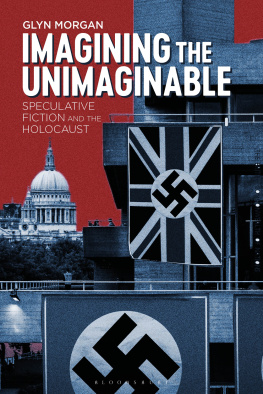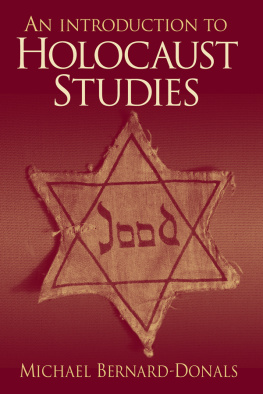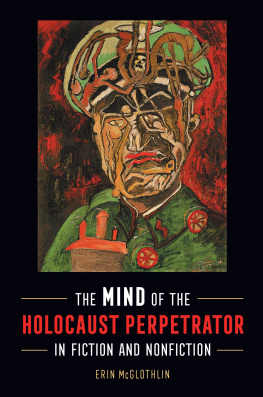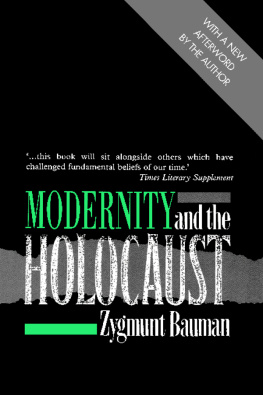Imagining the Unimaginable
Dedicated to all victims of fascism
Imagining the Unimaginable
Speculative Fiction and the Holocaust
Glyn Morgan

Contents
This book would not exist without the support and contributions of a wide range of people, more than I could possibly list. However Id like to pay particular tribute and thanks to my peers, mentors and friends who have lifted my spirits when this project seemed endless and overwhelming, enriched my research through their recommendations and conversations, listened patiently to research papers and lectures and asked searching and thought-provoking questions, or have just been there for me when it all felt too hard.
So thank you to my University of Liverpool PhD cohort and departmental staff, the many many amazing new scholars who have come through CRSF over the years, the SFRA and BSFA communities, the LSRFC crew, my Prestatyn posse, my Hay Festival family, my Waterstones warriors, and the amazing team at the Science Museum who have been the most recent to welcome me so warmly. Thank you too to Katherine De Chant and everyone at Bloomsbury for supporting this book.
Huge thanks to Katherine Bishop, Mark Bould, Andrew M. Butler, Amy Butt, Amy and Tom Carroll, Molly Cobb, Cate Cowton, Nick Davis (we miss you Nick), Sarah Dillon, Robert Eaglestone, Neil Easterbrook, Caroline Edwards, Alice Felstead, Andrew Ferguson, Pawel Frelik, Leimar Garcia-Siino, Francis Gene-Rowe, Natalie Hannah, Emma Hayward, David Hering, Nicola Hill, Matthew Hitchcock, Stephen Hoggarth, Edward James, Sing Yun Lee, Roger Luckhurst, Anna McFarlane, David McWilliam, Farah Mendlesohn, Keren Omry, Danny OConnor, Matthew ODonoghue, Chris Pak, Grace Redstead, Deryn Rees-Jones, Adam Roberts, Bethan Roberts, Andy Sawyer, David Seed, Will Slocombe, Katie Stone, Rhys Williams, Peter Wright, Michelle Yost. Theres part of you all in here somewhere, but it goes without saying any errors and shortcomings are mine alone.
I am grateful to the Wiener Library for the Study of the Holocaust and Genocide and the staff of Humanities 1 at the British Library for their extensive resources and for allowing me the regular use of their excellent reading rooms.
Finally of course, my family, in particular my parents Tony and Wendy Morgan whose support has been invaluable, and Anna Garnett who held me together even when I was extremely difficult.
This book developed from my dual interests in representations of atrocity and trauma, and the manner in which alternate history manipulates historical narrative. In particular, over the course of my research it soon became evident that the critical dialogue surrounding the Holocaust, and its representation in fiction and art, provide a unique friction against the limitless possibilities of science fiction, fantasy and alternate history genres which we can group, however loosely, under the label speculative fiction (SF). Yet the fictional texts which occupy this niche have received an uneven critical reception, with a few high-profile texts overshadowing what is in fact a broad selection dating back to the Second World War and continuing to attract new fictions today, ranging from science fiction pulp to literary fiction via bestselling popular thrillers.
The Holocaust occupies a unique position in Western cultural thought: there is no other event in the common history of humanity which is so heavily studied and written about and simultaneously coded as uninterpretable and unapproachable. Nonetheless, attempts to interpret, approach and understand are legion, not least through the medium of fiction. It could be that these texts persist as an artistic development of Freuds concept of durcharbeiten , or working through, an expression of Anglo-American readers continued fascination with not only the Second World War and the Nazis, but with the greatest crime of that conflict.
Yet, the sheer weight of numbers removes none of the problems or controversies surrounding representation. Many representations of the Holocaust in fiction draw upon the implicit assumption that its traumatic experience cannot, and perhaps should not, be conveyed through art. This is a situation perhaps true of other traumatic and significant events both personal and societal, but in this as in many other things the Holocaust supersedes them. For example, in an influential and relatively early survey of the field of Holocaust literature, Alvin H. Rosenfeld wrote that the Holocaust occupies another sphere of study compared to other topical literatures about the family, of slavery, of the environment, of World War I or World War II, continuing that Holocaust literature force[s] us
The Holocaust has been consistently rendered as Other by scholars, as an earthquake, another planet, another universe, a rupture, a void, as being beyond language, or else having its own incomprehensible tongue. It should not, therefore, be surprising that such an event has attracted the attention of literature which routinely engages the Other, the uncanny, the grotesque and the inhuman. From Katharine Burdekins prophetic Swastika Night (1937) to Lavie Tidhars revolutionary A Man Lies Dreaming (2014), these non-realist responses to Nazi Germanys persecution and attempted extermination of the Jews are as continuous a presence as any realist fiction or historical essay. And yet, the Holocaust has also been said to be totally beyond art, to the extent that survivor Elie Wiesel wrote of the impossibility of the Holocaust as Literary Inspiration.
Often presented as an event on the cusp of modernity and postmodernity, the Holocaust has been suggested as being perhaps even the source of postmodernity through the responses of Emmanuel Levinas, Jacques Derrida, Walter Benjamin and others, leading to the opinion that postmodernism understood as poststructuralism begins with the Holocaust. While this is by no means an irrevocable truth, there is nonetheless a noteworthy disconnect between a representation of the Holocaust and an SF novel written in a style more akin to a nineteenth-century scientific romance than a late-twentieth-century piece of postmodern trauma fiction such as D. M. Thomass The White Hotel (1981). Similarly, there is tension between the unapproachability of the Holocaust which, if it must be represented, seems to insist upon high art (whatever that is), and the low popular genres of SF.
These tensions between postmodern unrepresentability and popular fiction, traumatic caesura and SF storytelling, high subject and low art, are key discussion points which will be explored in the coming chapters. However, there is another motivation behind a study such as this. I am not Jewish nor, to the best of my knowledge, do I have a personal connection to anyone who was a victim of Nazi atrocity in any manner atypical for a British citizen of the time. However, as is reflected by many (though by no means all) of the authors in this book having a similar relationship to my own, the experience of the Holocaust has become entwined within the Anglo-American historical consciousness and in doing so has become a crucial thread in the history of humanity. Yet, those individuals who experienced the atrocity first-hand (whether survivor, participant, or even bystander) are now mostly gone, a fact made all the more obvious by the recent death of one of the most vocal survivors of the Holocaust, Elie Wiesel, in 2016.
We are entering a new phase in our relationship with the Holocaust, that of the post-survivor era. In this unprecedented time, it is crucial that we bolster all our resources and efforts to re-learning the horrors of war and genocide, the outcomes of intolerance, fascism and hatred. Now, perhaps more than any time since 1945, as the far-right makes inroads across the map of Western democracy, we need to look at the Holocaust, and atrocities like it, through every lens at our disposal, and analyse it with every tool in our kit. SF, and non-mimetic fiction more broadly, is one such tool, and an underutilized one with regard to Holocaust studies.










